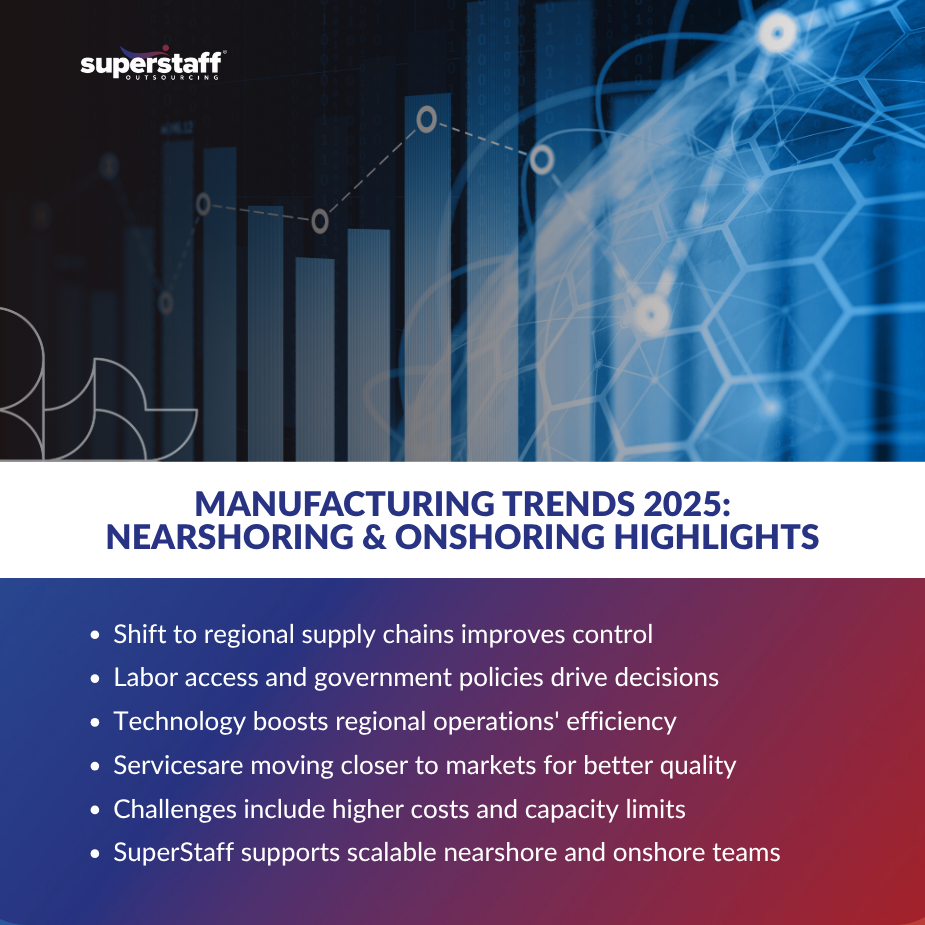
Higher freight costs and frequent poGlobal supply chains are be restructured. Ongoing trade disruptions, rising shipping costs, and shifting labor markets are pushing companies to rethink where and how they operate. Many are now moving production and services closer to their main markets.
Nearshoring and onshoring are key strategies for reducing delays, improving flexibility, and managing risk. These models are especially relevant to manufacturing trends 2025, where speed, quality, and cost efficiency drive decision-making.
Businesses across industries are exploring regional operations to stay competitive. Understanding the benefits and challenges of this shift will be essential for long-term planning and sustainable growth.

Moving from Global to Regional Supply Chains
Companies are reducing their dependence on long-distance shipping. Instead of relying on far-off suppliers, many are turning to regional solutions.
Key drivers include:
- Global disruptions such as trade disputes and public health issues
- A growing demand for quicker delivery
This shift is a strong example of localization in action in the supply chain. Businesses want more control and fewer weak points in their supply routes.
This growing trend fits within broader manufacturing trends 2025, where efficiency and stability are major priorities.
Labor Cost and Talent Availability
Labor is a major reason why companies choose nearshoring or onshoring.
Benefits of nearshoring for U.S. companies include:
- Access to skilled workers at lower costs than domestic options
- Faster hiring due to shared time zones and regional talent pools
- Better retention due to cultural alignment and workplace standards
Meanwhile, onshoring brings its own advantages:
- Job creation within the U.S.
- Easier legal and regulatory compliance
- Reduced language and cultural barriers
However, rising wages in Asia and talent shortages in key countries are pushing more companies to look closer to home. These decisions reflect long-term labor strategies tied to manufacturing trends in 2025.
Government Policies Support Regional Operations
Governments around the world are ramping up efforts to encourage companies to bring jobs and services back through a combination of legal and financial incentives. Here are some of the most recent developments:
- The proposed Bring Jobs Home Act (S. 2569) — initially introduced in 2014 — would provide U.S. companies up to a 20% tax credit for insourcing expenses and deny deductions for outsourcing costs.
- Trump’s “New American Industrialism” – President Trump has pitched a plan combining lower corporate tax rates (around 15%), land offers, tariffs for offshoring firms, and a “manufacturing ambassador” to recruit foreign manufacturers back to the U.S.
This support helps make regional operations more cost-effective. It also encourages companies to focus on reshoring manufacturing—a major element of future business planning.
Strengthening Supply Chain Resilience
Business leaders want stable operations that can handle change. That’s why many are adjusting their supply chain strategy to focus on risk reduction.
Why nearshoring and onshoring help:
- Onshoring reduces exposure to political and shipping risks
- Nearshoring keeps production close but flexible
- Regional diversification spreads out risk instead of concentrating it in one place
Today, resilience matters as much as cost. As part of manufacturing trends 2025, companies are investing in onshoring solutions for supply chain resilience instead of chasing the lowest price.
Technology Supports Regional Models
Recent tech improvements make it easier to manage operations across borders, even if they are close by.
Helpful tools include:
- Cloud systems for real-time updates and inventory tracking
- Communication tools for working with nearshore partners
- Automation that lowers costs for domestic production
These tools reduce the need to manage teams in distant time zones. They also make it easier to coordinate with regional partners. This is helping companies keep up with manufacturing trends 2025 while staying efficient.
Services Are Shifting Closer, Too
Services are also moving closer to the companies they support, following the trend of nearshoring and onshoring seen in manufacturing. Many businesses are relocating customer service, IT support, and back-office teams to nearby countries or domestic locations. This shift improves response times because teams operate within similar time zones, allowing faster communication and quicker problem resolution.
Bringing service teams closer also reduces miscommunications. Shared language, culture, and business practices help teams better understand customer needs and avoid errors. This leads to higher service quality and stronger customer relationships. Nearshore and onshore outsourcing give companies more control and flexibility, supporting smoother operations and long-term growth.
What’s Ahead in the Next Five Years
Looking forward, regional operations will become more common. Businesses will use a mix of offshoring, nearshoring, and onshoring to match different needs.
Expect these trends:
- Hybrid outsourcing models – Companies will combine global, regional, and domestic teams for flexibility.
- Growth in North and Latin America – Demand for nearshore partners will increase, especially in countries with strong infrastructure.
- Stronger outsourcing partnerships – Businesses will rely on experienced providers to manage local teams and ensure performance.
All of these point to a broader shift in manufacturing trends in 2025, where adaptability and location play bigger roles.
Challenges to Consider
While nearshoring and onshoring offer many benefits, there are some barriers to keep in mind. Challenges of onshoring manufacturing processes include:
- Higher labor costs than overseas options
- Limited domestic capacity in some industries
- Upfront investment in new facilities and employee training
- Longer lead times to ramp up production
- Difficulty finding skilled workers in certain regions
- Increased regulatory and compliance requirements
- Potential supply shortages for raw materials domestically
Still, many companies believe the long-term benefits outweigh these costs. As manufacturing trends 2025 evolve, businesses are finding ways to balance cost, speed, and reliability.
Nearshore. Onshore. Right Where Your Growth Needs To Be
Nearshoring and onshoring are reshaping how businesses manage operations. As companies move toward more regional models, these strategies are becoming essential for improving control, reducing risk, and staying competitive.
SuperStaff supports this shift by helping U.S. businesses build dedicated nearshore and onshore teams tailored to their needs. From customer service and technical support to back-office processing and manufacturing assistance, we offer scalable solutions that align with your long-term growth strategy. Our teams operate from strategic locations in the U.S., Colombia, and the Philippines, ensuring seamless communication, time zone alignment, and cultural compatibility.
Plan ahead for manufacturing trends 2025. Choose SuperStaff for nearshoring and onshoring solutions built to grow with your business, closer to home.






